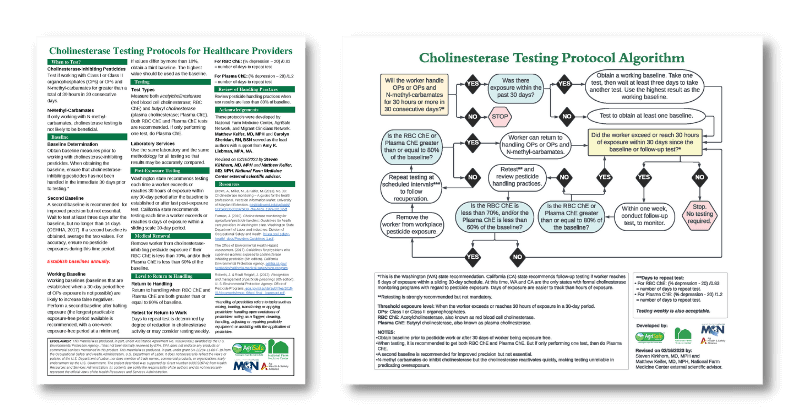Emergency Medical and Field Fumigation Guides for Methyl Bromide, Methylisothiocyanate (MITC), Chloropicrin, and Metam Sodium/Metam Potassium.
- Emergency Medical Treatment Guide-Methyl Bromide.pdf (19.8 KB)
- Emergency Medical Treatment Guide-MITC.pdf (25.2 KB)
- Field Fumigation Emergency Responder Guide-Chloropicrin.pdf (50.73 KB)
- Emergency Medical Treatment Guide-Chloropicrin.pdf (19.41 KB)
- Field Fumigation Emergency Responder Guide-Metam.pdf (59.81 KB)
Physicians, nurses, nurse practitioners, physician assistants, paramedics and other health care professionals often encounter work-related health and safety issues as they care for their patients. The Clinicians' webpage provides information, resources and links to help clinicians navigate OSHA's website and provide care for workers. Topics on the webpage include evaluating occupational exposures, OSHA requirements for recordkeeping and medical records, and setting up a safe outpatient office.
The California Healthcare News regularly posts jobs around the state. Check back frequently for updated information.
Cancer statistics for Hispanics/Latinos, 2012 by Rebecca Siegel MPH, Deepa Naishadham MA, MS, Ahmedin Jemal DVM, PhD
Article first published online: 17 SEP 2012
Abstract
Hispanics/Latinos are the largest and fastest growing major demographic group in the United States, accounting for 16.3% (50.5 million/310 million) of the US population in 2010. In this article, the American Cancer Society updates a previous report on cancer statistics for Hispanics using incidence data from the National Cancer Institute, the Centers for Disease Control and Prevention, and the North American Association of Central Cancer Registries and mortality data from the National Center for Health Statistics. In 2012, an estimated 112,800 new cases of cancer will be diagnosed and 33,200 cancer deaths will occur among Hispanics. In 2009, the most recent year for which actual data are available, cancer surpassed heart disease as the leading cause of death among Hispanics. Among US Hispanics during the past 10 years of available data (2000-2009), cancer incidence rates declined by 1.7% per year among men and 0.3% per year among women, while cancer death rates declined by 2.3% per year in men and 1.4% per year in women. Hispanics have lower incidence and death rates than non-Hispanic whites for all cancers combined and for the 4 most common cancers (breast, prostate, lung and bronchus, and colorectum). However, Hispanics have higher incidence and mortality rates for cancers of the stomach, liver, uterine cervix, and gallbladder, reflecting greater exposure to cancer-causing infectious agents, lower rates of screening for cervical cancer, differences in lifestyle and dietary patterns, and possibly genetic factors. Strategies for reducing cancer risk among Hispanics include increasing utilization of screening and available vaccines, as well as implementing effective interventions to reduce obesity, alcohol consumption, and tobacco use. CA Cancer J Clin 2012;. © 2012 American Cancer Society.
Latinas are experiencing high rates of sexually transmitted diseases (STDs), teen childbearing, and unintended pregnancy. This report presents nine recommendations for sexual and reproductive health clinics and providers to increase young Latina women’s access to reproductive health services. The recommendations are based on findings derived from 14 focus groups conducted by Child Trends in three cities in the United States with young adult Latina women (18-24 years-old) and with reproductive health care and social service providers serving large Latina populations.
New research out of Cornell University's College of Human Ecology found that low-income children of immigrants have much poorer health than low-income children of citizens, as reported in a special section of the journal Child Development.
http://www.farmworkercliniciansmanual.com
This comprehensive manual was developed by the New York Center for Agricultural Medicine and Health and the Migrant Clinicians Network for the diagnosis and treatment of occupational injuries in migrant and seasonal farmworkers. The information in the manual does focus on agricultural occupations in the Northeast.
In honor of Mother’s Day, we’re proud to announce that our Safe Pregnancy and Birth mobile app is now available for free as a beta release for Android phones. Click here to download it now from the Google Play app store. In January, we released our app for iPhones; click here to download it from the Apple store. If you don’t have an Android or iPhone, you can preview the app here
- http://e2ma.net/go/11032126792/208891732/234042635/35444/goto:https://play.google.com/store/apps/details?id=org.hesperian.safepregnancyandbirth
- http://e2ma.net/go/11032126792/208891732/234042636/35444/goto:http://itunes.apple.com/us/app/safe-pregnancy-and-birth/id496919735?mt=8
- http://e2ma.net/go/11032126792/208891732/234042637/35444/goto:http://hesperian.org/books-and-resources/safe-pregnancy-and-birth-mobile-app/

These Cholinesterase (ChE) clinical tools provide a concise and simple format to guide clinicians in monitoring the ChE levels for patients working with Class I and Class II organophosphates (OP) or OP and N-methyl-carbamates.
An Action Plan for Implementing a Primary Care Clinician’s Evidence-Based Toolbox and Guide.
- CRC Action Plan brochur PAGE 1-11_0.pdf (621.73 KB)
One page document designed to educate clinicians about important elements of colorectal cancer screening using fecal occult blood tests (FOBT). Provides state-of-the-science information about guaiac and immunochemical FOBT, test performance and characteristics of high quality screening programs.
- FOBT Clinician's Reference Final 2012_0.pdf (298.33 KB)
This is a comprehensive, practical toolkit for primary care sites to implement more effective colon screening practices. Even though highly effective methods of CRC screening are available across the country, the current rates of screening, and of complete diagnostic examination that should flow from screening, remain inadequate. Thus, the potential benefits of widespread CRC are unrealized. The American Cancer Society has established the goal of 75 percent of the eligible population screened for CRC by the year 2015. This guide will help us reach that goal.
- acspc-024588sm.pdf (1.95 MB)
This booklet is intended to help Community Health Centers put in place an effective and efficient workers' compensation program.
- MedicalServicestoWorkers-2012.03.27.pdf (5.57 MB)
To provide guidelines for a thorough and consistent management of immunizations to our Clients throughout the Waimanalo Health Center.
- 2004+immunization+protocol.doc (35 KB)